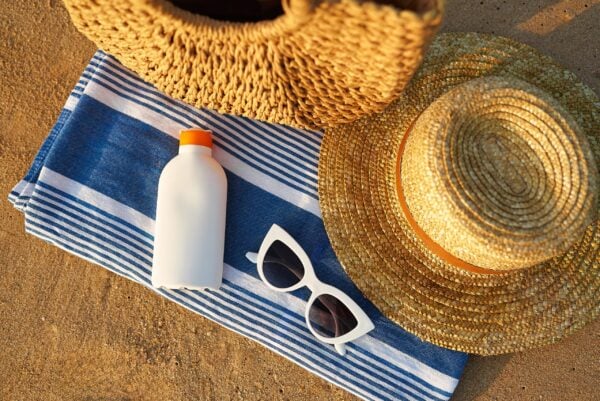
Sun protection isn’t just for beach days anymore—it’s a daily essential. Whether you’re serious about checking the UV index or simply want to protect your skin without making it complicated, building sun safety into your everyday routine is key to long-term skin health.
Why? Because while a sunburn might fade quickly, effects like fine lines, dark spots, and a weakened skin barrier can last much longer. And that’s just the cosmetic side: Dermatologists see the full spectrum of sun damage every day, from premature aging to painful burns and even skin cancer.
That’s why experts recommend more than sunscreen for protection. A real-life, dermatologist-approved sun protection routine includes wearing protective clothing, seeking shade whenever possible, planning time outdoors strategically, and choosing the right SPF for your lifestyle.
So if you’re ready to give your skin the protection it deserves, read on. We’ll break down exactly what works and how to make it fit into your everyday routine.
The science of UV rays (no lab coat needed)
Let’s start with why sun protection is important in the first place. The sun emits ultraviolet (UV) radiation, which comes in different wavelengths. When it comes to skin damage, UVA and UVB are the two big ones you should care about.
- UVA = Aging. These rays penetrate deep into your skin, causing fine lines, wrinkles, and dark spots.
- UVB = Burn. These are the culprits behind sunburns and are strongly linked to skin cancer.
Both types can damage skin cells in people of all skin tones. That means sun safety is essential for everyone, not just those who burn easily.
Though some people think we only need sunscreen when laying out by the water, UV rays don’t care if you’re lounging on a tropical island or sitting by a window answering emails. The sun reaches you whether you’re beachside, going for a hike, or commuting to work, and your skin doesn’t know the difference.
And it doesn’t even have to be sunny out. UV rays make it to your skin just as easily on foggy or cloudy days. Bonus danger: Rays bounce off water, sand, and even snow, so you can get double-dosed without realizing it.
Your skin’s best friends: shade, clothing, and sunscreen
To help protect your skin from harmful UV rays, here’s the holy trinity of sun protection:
- Seek shade. Trees, umbrellas, and wide-brimmed hats help create a sun safety zone. Try to avoid sun exposure between 10 am and 2 pm, when UV rays are strongest.
- Suit up. UV-rated clothing, long sleeves, pants, and “rash guards” aren’t just for surfers anymore. Pro tip: These don’t make you overheat. In fact, many are made to be breathable and comfy, even in summer.
- Slather on sunscreen. Not just any old lotion will do. Choose a brand that is broad-spectrum (blocks UVA and UVB), SPF 30 or higher, and water-resistant if you’re sweating or swimming. Remember, it’s vital to reapply sunscreen every two hours for the best protection.
What is the best sunscreen? The one you’ll actually use (and reapply!)
Let’s be honest: picking a sunscreen these days can feel like online dating. Creams, lotions, sprays…tinted, sheer, water-resistant, reef-safe…it’s a lot. But don’t stress. The best sunscreen is the one you like enough to actually use and reapply. Consistently. (Yes, even when it’s cloudy. Yes, even in winter.)
Here’s what dermatologists want you to know: look for something that’s SPF 30 or higher and water-resistant. SPF 30 blocks about 97% of UVB rays, and while higher SPFs can offer a bit more protection, no sunscreen blocks everything. That’s why it’s also key to choose a broad-spectrum formula since this protects against both UVB rays and UVA rays.
Sunscreens come in two main formulations: chemical and mineral.
- Chemical sunscreens include filters like oxybenzone, avobenzone, and homosalate that absorb UV rays. They’re lightweight, often invisible, and need about 20 minutes after application to work.
- Mineral sunscreens (also called physical blockers), such as zinc oxide and titanium dioxide, sit on the skin and reflect rays immediately. They’re less likely to irritate sensitive skin and are great for kids and anyone who wants a more natural option. Newer mineral formulas are not the chalky white mess your mom used in the ’90s. Many come tinted – perfect for blending with darker skin tones or replacing your BB cream.
Unfortunately, applying sunscreen as part of your morning skincare routine is not always enough. Both chemical and mineral sunscreens require maintenance throughout the day. To be effective, all sunscreens need to be reapplied at two-hour intervals when you’re outdoors.
Whether you opt for chemical or mineral protection, there are still lots of options to help you find your favorite sunblock. Different formulas work better for different situations and skin types. Here’s a cheat sheet:
- Creams are great for dry skin. Think elbows, legs, and faces that need a little extra hydration.
- Gels are ideal for oily skin or hairy areas like the chest or scalp.
- Sprays are convenient for squirmy kids and beach reapplications, but don’t skip the rub-in step. Spray until skin glistens, then blend. Never spray your face; spray your hands, then apply.
And don’t forget SPF lip balm. Your lips can burn, too!
The shot glass rule: The only daytime shot you should be taking
Forget tequila or wheatgrass—this shot’s all about sun safety. Even with the best sunscreen, it’s important to use an adequate amount. Most adults need a full ounce of sunscreen (enough to fill a shot glass) to properly cover their whole body. Apply it 15 minutes before going outside, and reapply every two hours or sooner if you’re sweating, swimming, or living your best summer life.
What about kids and babies?
When it comes to sun protection, babies and young kids need a little extra care. For infants under 6 months, it’s best to keep them out of direct sunlight whenever possible. If your baby does need to be outside, dress them in lightweight, sun-protective clothing and use a canopy or stroller shade to block the rays.
Once your child is over six months, you can safely introduce sunscreen into the routine. Look for baby formulas made with mineral-based ingredients. They’re gentle on sensitive skin and offer reliable protection. For the best protection, pairing sunscreen with sun-protective clothing is a smart move. Long sleeves, wide-brimmed hats, and UV-blocking swimwear help keep little ones safe while they play.
But don’t I need the sun for vitamin D?
Yes, it’s true that the sun helps our bodies make vitamin D. But here’s the deal: there’s no such thing as a “safe tan.” The UVB rays that are important for vitamin D synthesis also increase your risk of skin cancer, premature aging, and all the stuff you don’t want.
The good news? You don’t need to roast yourself like a rotisserie chicken to get your daily D. The American Academy of Dermatologists recommends getting vitamin D from dietary sources instead. Fortified foods like milk, OJ, and even mushrooms can help, and your doctor can recommend a supplement if needed. This is especially important if you have darker skin, which naturally blocks more UVB and can make vitamin D levels harder to maintain.
Sun safety can still be fun!
Sun protection doesn’t mean becoming a vampire. It means being smart — so you can keep enjoying the outdoors without sacrificing your skin’s future. Think of sunscreen like a daily moisturizer with superpowers. Pair it with a wide-brimmed hat, a cute pair of sunglasses, and your favorite beach read, and you’re ready to go.
If you need more personalized guidance on sun protection or any skincare concerns, find a Forefront location near you today to schedule a consultation with a board certified dermatologist.





